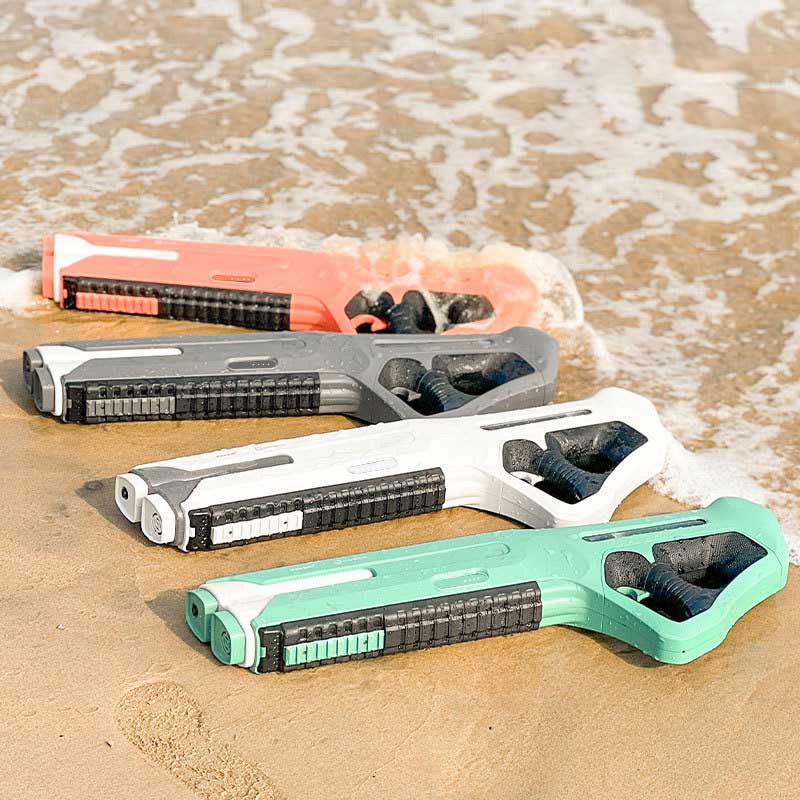No Products in the Cart
- sales@biu-blaster.com
- The following requirements are met for automatic discounts,as follows!
When those hot summer days arrive, gather friends and family for an epic water gun battle! While entering an intense soaker face-off unprepared means a quick defeat, this guide equips you with everything needed to splash your way to victory. Learn insider tips for choosing high-powered water weapons, battle preparation strategies, mastering offensive ambush and defensive evasion techniques, teamwork coordination, safety rules, and good sportsmanship. Follow this comprehensive advice on excelling at water fights to utterly drench opponents while defending your own turf in winning style when you make a splash this season!
Your most critical gear decision will determine whether you soak your enemies or yourself—picking the right weapon. Become a water gun expert by understanding the types available and key selection factors.
There are three main categories, each with pros and cons to consider based on your planned tactics.
Pistols:
Resembling their bullet-firing counterparts, water pistols maximize mobility and reload speed. Best suited for stealth missions, their compact size comes at the cost of limited range, power, and ammo capacity.
Rifles:
Offering mid-range power, capacity, and accuracy, rifles balance offense and maneuverability. Their versatile, steady performance from moderate firing distances makes them great all-purpose guns.
Blasters:
Fuel mega soaker battles with these high-powered beast blasters. Massive water tanks unleash an endless deluge of liquid mayhem but restrict your movement and carrying capacity.
Assess your playing style, opponents’ strengths, and the type of water fights expected. Then use these key comparisons when choosing your water weaponry.
Capacity:
Think about reloading needs based on battle length and water availability. More capacity means less frequent stops to refill.
Range & Power:
Consider necessary firing distance for battleground size and structures. Also, assess power requirements based on opponents’ guns.
Mobility & Ergonomics:
Maneuverability around obstacles, weight-carrying capacity for extended wear, and comfortable grip enable performance.
Weigh tradeoffs between firepower, transportability, precision, and capacity depending on planned tactics. Test different water guns to finalize the best fit.

Gearing up properly before an intense water gun face-off will keep you comfortable, protected, and ready to focus on your strategy.
Wear light, breathable, quick-drying clothes that won’t weigh you down when soaked. Choose fabrics that shed water well like nylon blends, polyester, and swim materials.
Protect eyes from high-pressure streams with sports goggles, while good foot traction aids rapid movement on slippery surfaces. Sunscreen, hats, and bandanas also safeguard from extended exposure.
Understand terrain intricacies, identify tactical positions, and chart water sources by scouting the predetermined battle zone ahead if possible. Note obstacles, shelters, high grounds, and shadows to incorporate into your plan of attack and defense. Agree on field boundaries everyone must respect.
Devise creative tactics aligned with your team’s strengths, tools, and opponents’ weaknesses.
Offensive Strategies:
Coordination allows multi-prong ambushes from multiple attack points like flanks or higher elevations. Stealthy reconnaissance enables locating and exploiting unprepared opponents.
Defensive Approaches:
Establish protected central bases with quick access to ammunition reserves as fallback positions. Erect barriers provide cover while allowing mid-range firing access.
Signals & Coded Communication:
Develop visual hand signs or coded phrases identifying formations, warnings, and attack commands allowing synchronized movements.
Unleashing devastatingly wet assaults demands properly wielding your soaker for maximum efficiency. Practice these offensive techniques pre-battle.
Mask sound and movements by using terrain like foliage and walls when flanking. Approach unsuspecting enemies’ blind spots slowly from behind for close sneak attacks.
Stage pre-planned synchronized multi-stream ambushes when adversaries cross established paths and destinations by discreetly anticipating their movements.
Master adjusting levels of stream intensity or volume and nozzle spray patterns for precision shooting. Estimate distances when leading moving targets to perfectly time hits.
Increase battleground coverage rate with cardio and maneuverability drills while carrying a loaded blaster. Strafing, jumping, and weaving practice maintain defenses while dodging return fire.
Follow offensive strike missions with immediate strategic fallback plans to prevent being pinned down under retaliatory barrages when ammo runs low.
Strong defensive capabilities ensure you withstand incoming water assaults when caught off guard. Integrate these protection strategies into plans.
Use structures, terrain contours, fixtures, and vegetation to obstruct opponents’ aiming capabilities. Constantly move between covers to limit exposure windows.
When encountering attacks in open zones, rapidly dodge streams using agile dodging, crouching, vaults, and fake-outs to reach safer spots. Serpentine randomly without patterns.
Fashion light makeshift shields from wood, plastic, or other water-resistant materials secured to your non-gun arm during forward advances or base hold.
Stage preplanned ambush points for pursuers when strategically falling back towards your base during heated exchanges.
Leverage defensive postures fully before transitioning them into deadly counter-offensives able to reverse tides.
Harnessing synchronized teamwork strengthens both offensive assaults and defensive capabilities exponentially.
Develop advanced battle plans centered around core strengths unique to specific team members. Gather frequent feedback to refine roles.
Example specialized designations include stealth agent, shock troop, sniper, spotter, lure, extraction driver, and supply coordinator.
Heat-of-the-moment battles drowned out by deafening water weapon explosions require pre-established hand signals to direct movements and formations.
Use signals indicating hold position, advance, cover fire, withdraw, flank left/right, ambush, abort, and distribute ammunition. Elaborate combinations expand coded language.
Follow this tactical advice for gaining winning advantages against even the fiercest super-soaker opponents during an all-out war.
Ration shots during long matches without quick refilling access. Burst fire in controlled intervals instead of exhausting full clips rapidly. Also, pack backup bottles for emergency reloads.
Stash spare prefilled containers at strategic forward rearming points. Create fast-release holsters to minimize fumbling. Designate reloaders as support crew.
Fake failed weapon functionality with false jam clearing or sputtering nozzle acts forcing opponents to disengage defenses. Feign wounds or exhaustion to mount surprise turnarounds when they approach.
Set expectations upfront and take precautions to facilitate fun within reasonable risk while deterring cheating.
Define field parameters and restrictions on weapon power, unsafe zones, direct facial shots, and off-limit equipment modifications enhancing impact velocity, pressure, or ammunition beyond reasonable sporting levels.
Regardless of game outcomes with bigger prize stakes, remain considerate of players' physical safety, limitations, and consent regarding intense soaking. Prioritize fun.
Check the playing field in advance removing dangerous debris and obstacles. Maintain first aid availability for minor impact abrasions and eye exposure incidents. Locate the nearest hospital beforehand given low risks.

Responsible post-game wrap-ups demonstrate maturity while positioning future rematches.
Confirm no litter debris remains onsite by collecting all equipment. Document any resultant property damage through photos and notify owners promptly with repair or compensation offers.
Completely drain, dismantle, clean, and dry soaker weapons to prevent internal deterioration, corrosion, and fouling which impair future functionality. Replace damaged O-rings maintaining airtight seals.
Regardless of whether your team secured the big trophy or suffered a bitter defeat, congratulate opponents afterward on creative strategies, acknowledge outstanding plays, and share laughs about memorable moments. Win or lose, attitude matters most.
Smart preparation, strategic planning, and specialized soaker techniques teach how to excel when engaging in these exciting summer activities. However, it remains most important to prioritize safety, responsibility, and fun before victory itself each time people gather to make lasting memories. So rally friends, stock up on water ammo, review the tips highlighted here, and then make record-setting splashes while enjoying friendly soaker competitions.